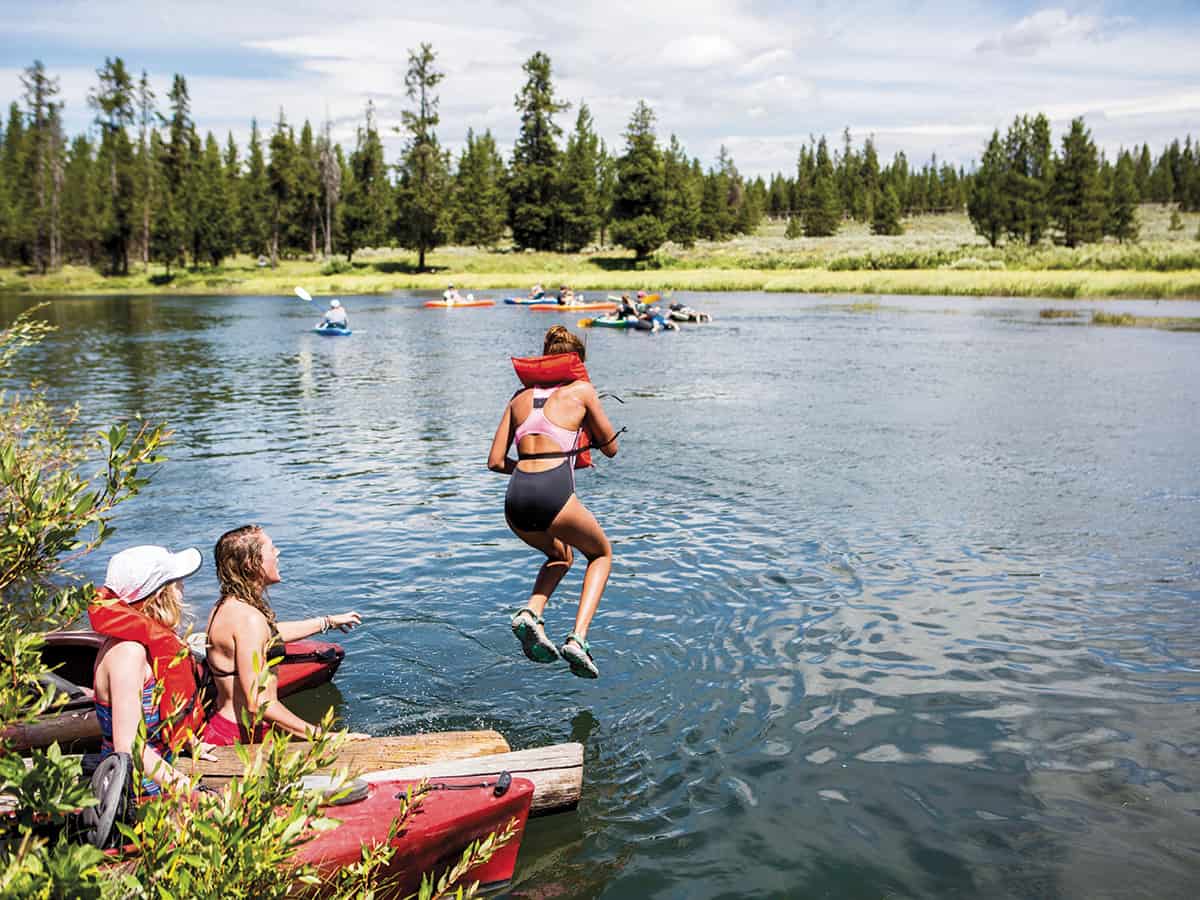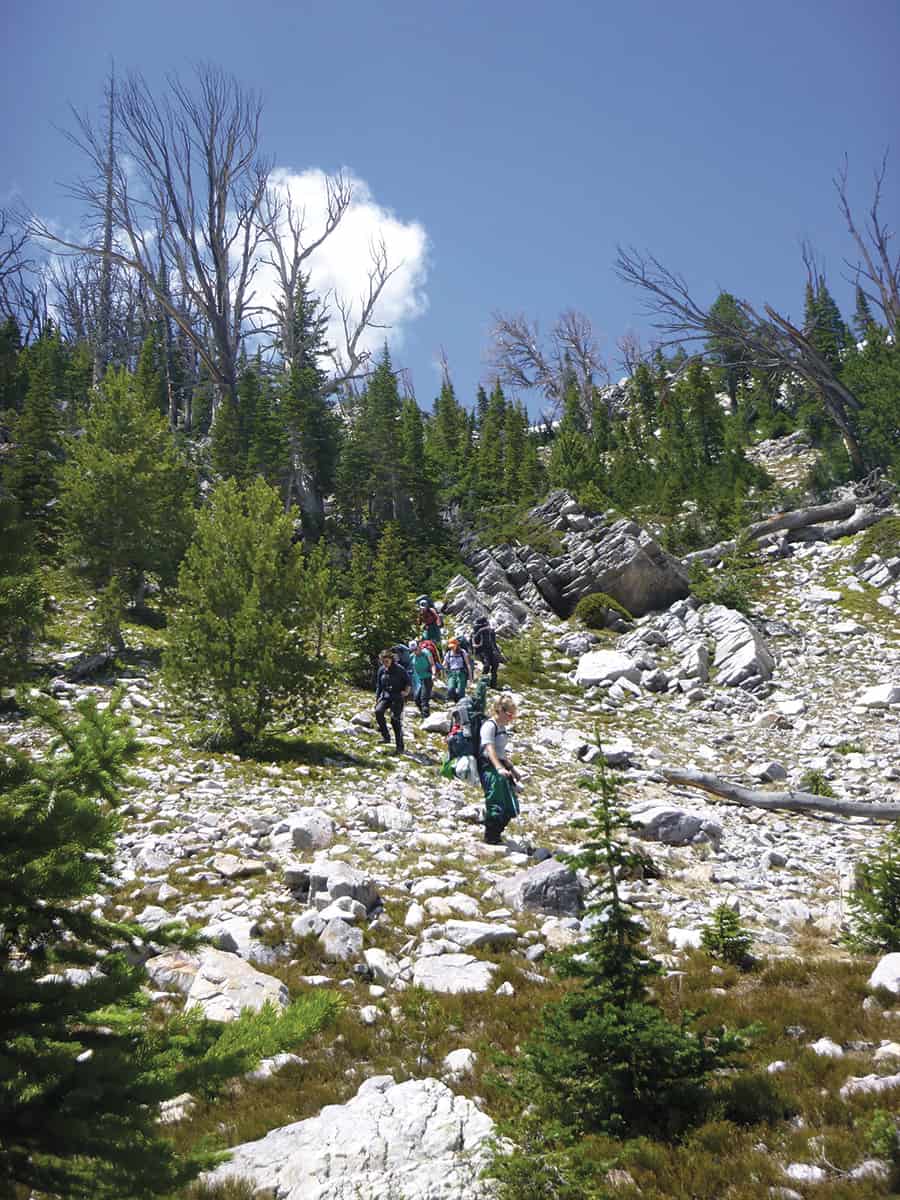By Georgie Stanley
—
Two summers ago my daughter Georgie attended Camp Wyonegonic in Denmark, Maine. This classic “American” summer camp resides on the shore of a big lake and boasts cabins, counselors, and uniforms—she loved it! Georgie came home after three weeks with a renewed sense of self and a better understanding of her own unique specialness. The change in her composure, and her newfound relaxed self-confidence, made me a believer in both the summer camp model and the all-girl setting as powerful medicine.
Now I get it. Most Teton families spend tons of time outside in the mountains, on rivers, and on bikes, and they benefit greatly from this quality time together. So why send your kids to camp? In summers past, I envisioned my kids eating peas off the vine in our garden, and then wandering off to play in the stream and make forts in the woods. This usually happened once or twice, but there were many days strung together when they needed the stimulation of a new experience and more time with friends.
We romanticize about the great summer trips we’ll do with our kids. (I know I do, year after year.) Yet unintentionally, they end up in front of a screen or inside the house more than we anticipated.
So, I’m sold on summer camp, for multiple reasons. Such as …
Raising girls is not for the faint of heart. They metamorphose so quickly from little kids into adolescents that it’s hard to keep up with the changes. But a camp redirect can help girls stay on track during the confusing and potentially destructive phases of tween and teenagerdom. Time away from family, among a strong network of girls, allows them to chart their own course and feel proud of their independence. And the lack of social media helps girls simply be in the moment, in nature, and not worry about what they look like and how they should act. Outdoor camps, and the positive young role models that come with them, offer unlimited opportunities for fun, challenge, and simple pleasures.
Plus, there are serious life-altering issues that can be averted during this tricky time between childhood and adulthood. Jess Yoemans, executive director of GAP! (Girls Actively Participating!) in Jackson, notices a big difference between girls in sixth grade and those in seventh grade. “In seventh grade, girls start to feel judgment,” she explains. “The spotlight comes from parents, teachers, coaches, friends, and also themselves. They change from the ‘I am an awesome little girl’ into a more complex creature that is easily jilted. And it happens fast!”
It is during this transformation that positive role models can provide support and encouragement for our budding girls. And that’s where the camp counselor comes in.
“The organized summer camp is the most important step in education that America has given the world.”
– Charles W. Eliot, president of Harvard University 1869–1909
We are not their peers, nor are we their camp counselor. Enter the ultimate female role model. Yep, she’s young, but she has also reached a level of self-assurance and maturity that permits her to help guide teenage girls gently and with intention. Camp counselors extraordinarily influence our girls by sharing their path in life; by opening the door of possibility for our daughters. Counselors drive home ideas like cleaning up after yourself or standing up straight, which, coming from parents, often fall on deaf ears. In fact, the caliber of counselors is so vital to the success of the camp experience that many camps source their best staff from alumni campers who have already experienced the deep emotional shift that camp delivers. And they are eager to help recreate that occurrence for others.
The all-girls setting rocks! “An all-girls setting allows girls to be leaders and to take chances they might not take in a coed group,” explains Alissa Farley, camp director and founder at Alpengirl in Manhattan, Montana. The all-girl model offers girls a sense of security when trying new activities that are intimidating. Abby Warner, director of the Teton Valley NOLS (National Outdoor Leadership School) branch in Driggs, says that while her organization is “intentional about creating a less-gendered environment,” it’s sometimes “easier for girls, and boys, to develop skills—that don’t come naturally to them—in a single-sex situation.” Also, there’s less distraction so that they can focus more on themselves.
And speaking of distractions …
“They strip off their makeup and get away from screens and pressures.”
– Quincy Van Winkle, Camp Wohelo
Many girls’ camps have uniforms and most camps will ask your daughter to leave her phone, iPad, and music behind. Stripped of the trappings of adolescence, girls land on an even playing field. Being in uniform breaks down preconceived barriers and the preoccupation with “others” fades into the background. At camp, girls can celebrate their individual characters, and their heightened sense of self-consciousness melts away. Quincy Van Winkle of Camp Wohelo in Raymond, Maine, explains how girls often come to camp beat down by friends, cliques, and social media. “They strip off their makeup and get away from screens and pressures. And by the end [of the session], their eyes and intentions are clearer and they’re standing more erect,” she says.
However, camp life is not immune to cliques and bullying. But by design, community social problems are often nipped in the bud. Camp counselors are trained to actively listen to campers’ conversations and watch for signs of destructive behavior, address issues as they arise, and create a culture that lifts up fellow campers, rather than pushing them down.
The camp experience is truly transformational. Girls don’t need to have cabins on a lake and uniforms to benefit from a summer break away from family. Out here in the West, enriching summer experiences revolve around adventure. On a NOLS trip, girls ages 14 and 15 venture into the mountains for two weeks. NOLS’ wilderness expedition model makes girls realize what’s really important in life—especially when it becomes all about finding your way, feeding your body, and working as a team, even when you’re cold and tired. It’s about living with a simplicity we cannot recreate at home. Warner says their all-girls trips are some of the most successful courses they run. “They’re out there problem solving, without relying on others,” she explains.
For younger girls, ages 11 to 16, Alpengirl’s camps bridge the gap between a close-to-home, facility-based youth camp and a challenging wilderness experience. Girls leave their screens behind to live in tents, but the backcountry portion is shorter than that of NOLS, and it’s interspersed with daylong activities. “Building self-esteem—while gaining leadership [skills] and confidence—is a natural result of our programs,” says Farley.
Last summer, Georgie didn’t return to camp in Maine, but instead attended a three-day-long camp run locally by GAP! It was open to all Teton Valley middle school girls and was packed with fun activities designed to ready them for school. With special workshops, GAP! leaders taught the girls how to support each other with integrity. Since then, every time Georgie runs into a girl from the GAP! camp, they embrace each other, shouting and hugging. These girls grew to love each other in just three power-packed days.
While the expense can be great and time is precious, I am so thankful the stars aligned and allowed Georgie the privilege of a camp experience at a pivotal time in her development. This summer, my only challenge will be figuring out how to find the time for her to get her camp on.


